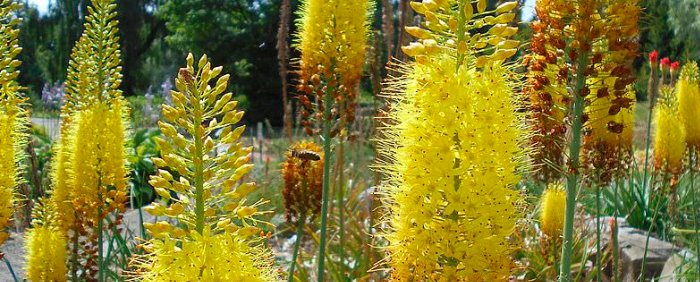
We are now focusing on Eremurus, because once installed, it is a very gratifying plant . It becomes big, flowers long enough, and has a surprising appearance.
Where does he come from and who are his parents?
Before marrying a new plant, do you want to know more about her family and region of origin?
Eremurus is a botanical genus of 60 perennial species with fleshy roots . Most are from Central Asia – hence the name “steppes”.
Eremurus belong to the family Liliaceae , which is a family of monocotyledonous plants. If you know anything about botany, you can deduce that they have basal leaves with parallel, linear ribs 😉
The Eremurus has a surprising appearance, one can easily take it for an annual because of its speed of development, and the abundance of its flowering. Well actually it’s a perennial that needs the cold to thrive ! This plant has adapted to difficult conditions – continental climate – by the constitution of a very large fleshy root shaped octopus. This root consists of a large central bud around which are organized as star expansions.
These important reserves allow it to survive in dry and drained soils, limestone, clay, in full sun .
The stuff to keep his Eremurus alive for years.
- Choose the location carefully : it must be drained, rather alkaline, fertile, to light. It is especially important to avoid very humid sites during the winter.
- Beware of drafts , Eremurus can be bent in high winds. Some even have to guard him.
- If it does not freeze winter, your Eremurus will be unhappy, he needs cold . Its culture is therefore not recommended in the Mediterranean region.
- Do not move the roots once they are installed.
- Divide the feet after flowering , after 4 years, keeping for each division a piece of tuber and a bud. Use a knife – well cleaned! – rather than a spade.
How to use it?
The Eremurus is perfect to be installed in the heart of a massif : by correctly choosing the variety you can obtain plants that measure between 1 and 3 meters! It has a very erect floral stalk, which can slip between more bushy neighboring plants. The Eremurus come to form colorful candles that punctuate the massif , and avoid an appearance too confusing.
The disadvantage: some varieties are really “flashy” , so they must be used with discernment.
Some friends
How to associate and place the Eremurus?
Which works well.
Eremurus are not invasive despite their large size, so they are convenient to slip between other plantations.
- Intercalated with grasses Pennisetum style , they create a “steppe fleurie” effect, that is to say an evocation of high and dry meadows on which stand out colorful flowers.
- In association with fine blooms like that of the Verbena of Buenos Aires .
- In a massif with limited hues , the Eremurus will find its place, even with other blooms.
- With perennials that are lower and flower at another time : this is where the Eremurus is most useful because it animates the massif alone, does not take too much volume and can serve as a relay between blooms early and late blooms.
- In addition to the visual success of installing the Eremurus vaporous mass, they also operate in front of a background of dense foliage .
What works blah.
- With perennials or annuals of other colors that bloom at the same time : avoid because the eye does not know what to focus on.
- In isolated or in pot , the result is a frankly disappointing, because often the leaves disappear at the time of the flowering, so the foot is bald.